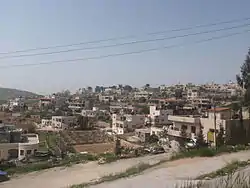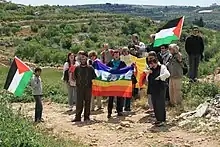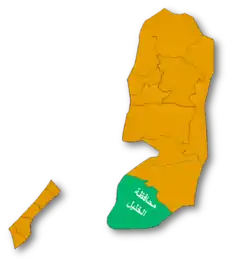Beit Ummar
Beit Ummar (Arabic: بيت اُمّر) is a Palestinian town located eleven kilometers northwest of Hebron in the Hebron Governorate of the State of Palestine.[2] According to the Palestinian Central Bureau of Statistics, in 2016, the town had a population of 17,892 inhabitants.[3] Over 4,800 residents of the town are under the age of 18. Since the Second Intifada, unemployment ranges between 60 and 80 percent due mostly to the inability of residents to work in Israel and a depression in the Palestinian economy.[4] A part of the city straddles Road 60 and due to this, several propositions of house demolition have occurred.[5]
Beit Ummar | |
|---|---|
| Arabic transcription(s) | |
| • Arabic | بيت اُمّر |
| • Latin | Bayt Ummar (official) Beit Omar (unofficial) |
 Beit Ummar, in 2011 | |
 Beit Ummar Location of Beit Ummar within Palestine | |
| Coordinates: 31°37′17″N 35°06′08″E | |
| Palestine grid | 159/114 |
| State | State of Palestine |
| Governorate | Hebron |
| Government | |
| • Type | Municipality (from 1997) |
| • Head of Municipality | Nasri Sabarna |
| Population (2016) | |
| • Total | 19,892 |
| Name meaning | "House of Ummar"[1] |
Beit Ummar is mostly agricultural and is noted for its many grape vines. This has a major aspect on their culinary tradition of stuffed grape leaves known as waraq al-'inib and a grape syrup called dibs.[5] Beit Ummar also has cherry, plum, apple and olive orchards.[6]
History
Beit Ummar is believed to be the site of Biblical village of Maarath.[6][7][8][9]
A church, tentatively dating to the 5th century CE, (but with changes probably done in the 8th century) was excavated in the 1930s at Khirbat Asida, to the east of the centre of Beit Ummar.[10]
According to some traditions, the town was named after the Islamic Caliph Umar ibn al-Khattab because he supposedly frequented the town. Many of the town's predominantly Muslim residents are descendants of Arab Christian families who converted during the 7th century Muslim conquest. Christian ruins in the old city are a testament to this conversion over 1,000 years ago.[5]

The main mosque in Beit Ummar houses the tomb of Nabi Matta. Matta refers to Amittai, the father of Jonah. Mujir ad-Din writes that Matta was "a holy man from the people of the house of the prophecy." Nearby Halhul houses the purported tomb of Jonah with the inscription reading "Yunus ibn Matta" or "Jonah son of Amittai", confirming that Matta is indeed the Arabic name for Amittai (some suggested it referred to the apostle Matthew); the Beit Ummar tomb is dedicated to Amittai.[11][12]
In 1226, the Ayyubid sultan al-Mu'azzam built a mosque with a minaret under the supervision of Jerusalem governor Rashid ad-Din al-Mu'azzami. The Mamluks constructed some additions to the mosque and engraved several inscriptions on its surface.[11]
Ottoman era
In 1838, Edward Robinson noted the village from Al-Dawayima.[13]
Victor Guérin visited the village in 1863, and found it to have about 450 inhabitants.[14] Swiss orientalist Albert Socin, noting an official Ottoman village list circa 1870, wrote that Beit Ummar had a total of 44 houses and a population of 133, though the population count included only men.[15] Hartmann found that Bet Ummar had 60 houses.[16]
In 1883, the PEF's Survey of Western Palestine (SWP) described Beit Ummar as a "small but conspicuous village standing on the watershed, and visible from some distance on the north. An ancient road passes through it. Half a mile north-east is a good spring, ‘Ain Kufin. The mosque has a small tower to it. The surrounding neighbourhood is covered with brushwood."[17]
British Mandate era
In the 1922 census of Palestine, conducted by the British Mandate authorities, Bait Ummar had a population of 829 inhabitants, all Muslims,[18] increasing in the 1931 census to 1,135, still entirely Muslim, in 217 inhabited houses.[19]
In the 1945 statistics the population of Beit Ummar was 80 Jews and 1,600 Muslims, and the total land area was 30,129 dunams of land, according to the official land and population survey.[20][21] 2,912 dunams were plantations and irrigable land, 12,879 were for cereals,[22] while 55 dunams were built-up (urban) land.[23]
Jordanian era
In the wake of the 1948 Arab–Israeli War, and after the 1949 Armistice Agreements, Beit Ummar came under Jordanian rule. It was annexed by Jordan in 1950.
In 1961, the population of Beit Ummar was 2,103.[24]
Post-1967

Since the Six-Day War in 1967, Beit Ummar has been under Israeli occupation. The population in the 1967 census conducted by the Israeli authorities was 2,630.[25]
Beit Ummar became a municipality on April 17, 1997, after the dismantlement of the Israeli village council and Hussein Badr was appointed by the Palestinian National Authority.[5] The current mayor is Nasri Sabarna.[26] The town is currently located in Area B (civil affairs administered by the PNA) and Area C (civil and military affairs controlled by Israel).[5] Israel has confiscated[27] or expropriated[28] approximately 4,000 dunams of village land in order to construct Israeli bypass roads and several Israeli settlements: Karmei Zur, Migdal Oz, Kfar Etzion and Efrat.
The town is governed by a municipal council consisting of thirteen members including the mayor.
Several people in the village have been shot and killed by Israeli soldiers or settlers during Israeli occupation.
- In January 2011, Yousef Ikhlayl, 17 year old, was shot and killed during an altercation with Israeli settlers from Bat Ayin.[29][30][31]
- In August 2014, 3 Palestinians were shot and killed by Israeli military on the same day:
- Abdul Hamid Bregeith, a 32-year-old father of three,[32]
- Sultan Zaqiq, 29, a father of two,[32]
- Hashem Abu Maria, 45 years, all killed by IDF sharpshooter during a local protest. Abu Maria worked for Defence for Children International[32][33]
- In April 2015, Ziyad Awad, aged 27, was shot and killed in a demonstration which started after the funeral of his cousin.[34][35][36]
- In July, 2015, Falah Abu Maria, aged 52, was shot and killed by Israeli forces.[37][38]
- In July, 2021, Mohammed al-Alami, aged 12, was shot and killed by an Israeli soldier while he was riding in a car with his father and sister.[39][40]
- In July, 2021, Shawqat 'Awad, aged 22, was shot and killed during the funeral of Mohammed al-Alami.[41][42]
Notable people
References
- Palmer, 1881, p. 389
- Beit Ummar: Town Statistics and Facts
- 'Localities in Hebron Governorate by Type of Locality and Population Estimates, 2007-2016 ,' Palestinian Central Bureau of Statistics, 2016.
- Beit Omar Background
- Sample Area Background: Beit Ummar Archived 2007-12-12 at the Wayback Machine (2000) Campaign for Secure Dwellings, Christian Peacemaker Teams
- Beit Ummar: Where Dreams Come True Aging with Dignity in Palestinian Villages Qleibo, Ali. This Week in Palestine.
- Armstrong, 1889, p.119
- Hastings, James (2004) [1898]. A Dictionary of the Bible: Volume III: (Part II: O -- Pleiades) (reprint). Honolulu, Hawaii: University Press of the Pacific. p. 648. ISBN 978-1-4102-1727-1.
The ninth group is in the mountains north of Hebron, including Halhu (Halhul), Bethzur (Beit Sur), Maarath (Beit Umar), Beth-anoth (Beit Ainun), and Eltekon - perhaps Tekoa (Tekua).
- Wilson, John (1847). The Lands of the Bible Visited and Described, Volume 1. Edenburgh: William Whyte. pp. 386 – 387. OL 20556861M.
Beit-Ummar is on a heights to the left. It is apparently a considerable village... At least four of these villages are thus given in juxtaposition in Joshua, "Halhul, Beth-Zur and Gedor and Maarath, and Beth-Anoth, and Eltekon."
- Baramki and Avi-Yonah, 1934, pp. 17–19
- Sharon, 1999, pp. 161-164
- Clermont-Ganneau, 1899, p. 456
- Robinson and Smith, 1841, vol2, p. 401
- Guérin, 1869, p. 298
- Socin, 1879, p. 145
- Hartmann, 1883, p. 142
- Conder and Kitchener, 1883, SWP III, p. 303
- Barron, 1923, Table V, Sub-district of Hebron, p. 10
- Mills, 1932, p. 27
- Government of Palestine, Department of Statistics, 1945, p. 23
- Government of Palestine, Department of Statistics. Village Statistics, April, 1945. Quoted in Hadawi, 1970, p. 50
- Government of Palestine, Department of Statistics. Village Statistics, April, 1945. Quoted in Hadawi, 1970, p. 93
- Government of Palestine, Department of Statistics. Village Statistics, April, 1945. Quoted in Hadawi, 1970, p. 143
- Government of Jordan, Department of Statistics, 1964, p. 15
- Perlmann, Joel (November 2011 – February 2012). "The 1967 Census of the West Bank and Gaza Strip: A Digitized Version" (PDF). Levy Economics Institute. Retrieved 24 June 2016.
- Municipality Guide Nablus Municipality Official Website Archived December 4, 2007, at the Wayback Machine
- Beit Ummar Town Profile, ARIJ, pp. 15–16
- Agencies, IMEMC News &. "Soldiers Invade Beit Ummar". Retrieved 2020-02-22.
- Palestinian killed in clashes with settlers near Hebron, 01/29/2011, The Jerusalem Post
- Court releases hikers suspected of killing Palestinian teen 02/03/2011, Jerusalem Post
- Demanding justice for Yousef, a quiet boy killed by Israeli settlers, Bekah Wolf 27 January 2012, The Electronic Intifada
- A bullet through the heart of a Palestinian man - and an entire community By Gideon Levy and Alex Levac 15.08.14 Haaretz
- West Bank Palestinians die in fresh clashes, 25 Jul 2014, Al Jazeera
- 27-year-old Palestinian killed near Hebron after funeral of his cousin, 10 April 2015, Middle East Eye
- Palestinian killed in clashes with Israeli forces, 10 April 2015
- Palestinians: One Killed, Six Wounded in Clashes With Israeli Forces Ha'aretz 10/4/2015
- Israel kills dad as he tries to help injured son, Patrick Strickland, 24 July 2015, The Electronic Intifada
- Israeli Forces Shoot and Kill Palestinian During West Bank Raid, Diaa Hadid, July 23, 2015, The New York Times
- Israeli army kills Palestinian boy in West Bank: Ministry, 28 Jul 2021, Al Jazeera
- Beit Ommar: They killed his child and immediately took his working permit, Aug-5-2021, Machsom Watch
- Israeli forces kill young Palestinian man during funeral of 12-year-old boy, Akram al-Waara, 30 July 2021, Middle East Eye
- Border Police raid home of Beit Ummar resident, order her to stand by them on roof while stones were thrown at them, and force her to carry military equipment, 14 September 2021, B'Tselem
Bibliography
- Armstrong, George (1889). Names and Places in the Old and New Testament and Apocrypha. Committee of the Palestine Exploration Fund.
- Baramki, D.C.; Avi-Yonah, M. (1934). "An early Christian Church at Khirbat 'Asida". Quarterly of the Department of Antiquities in Palestine. 3: 17–19.
- Barron, J.B., ed. (1923). Palestine: Report and General Abstracts of the Census of 1922. Government of Palestine.
- Clermont-Ganneau, C.S. (1899). [ARP] Archaeological Researches in Palestine 1873-1874, translated from the French by J. McFarlane. Vol. 1. London: Palestine Exploration Fund.
- Conder, C.R.; Kitchener, H.H. (1883). The Survey of Western Palestine: Memoirs of the Topography, Orography, Hydrography, and Archaeology. Vol. 3. London: Committee of the Palestine Exploration Fund.
- Government of Jordan, Department of Statistics (1964). First Census of Population and Housing. Volume I: Final Tables; General Characteristics of the Population (PDF).
- Government of Palestine, Department of Statistics (1945). Village Statistics, April, 1945.
- Guérin, V. (1869). Description Géographique Historique et Archéologique de la Palestine. Vol 1; Judee, pt. 3.
- Hadawi, S. (1970). Village Statistics of 1945: A Classification of Land and Area ownership in Palestine. Palestine Liberation Organization Research Centre.
- Hartmann, M. (1883). "Die Ortschaftenliste des Liwa Jerusalem in dem türkischen Staatskalender für Syrien auf das Jahr 1288 der Flucht (1871)". Zeitschrift des Deutschen Palästina-Vereins. 6: 102–149.
- Hütteroth, Wolf-Dieter; Abdulfattah, Kamal (1977). Historical Geography of Palestine, Transjordan and Southern Syria in the Late 16th Century. Erlanger Geographische Arbeiten, Sonderband 5. Erlangen, Germany: Vorstand der Fränkischen Geographischen Gesellschaft. ISBN 978-3-920405-41-4.
- Mills, E., ed. (1932). Census of Palestine 1931. Population of Villages, Towns and Administrative Areas. Jerusalem: Government of Palestine.
- Palmer, E.H. (1881). The Survey of Western Palestine: Arabic and English Name Lists Collected During the Survey by Lieutenants Conder and Kitchener, R. E. Transliterated and Explained by E.H. Palmer. Committee of the Palestine Exploration Fund.
- Robinson, E.; Smith, E. (1841). Biblical Researches in Palestine, Mount Sinai and Arabia Petraea: A Journal of Travels in the year 1838. Vol. 2. Boston: Crocker & Brewster.
- Sharon, M. (1999). Corpus Inscriptionum Arabicarum Palaestinae, B-C. Vol. II. BRILL. ISBN 978-9004110830.
- Socin, A. (1879). "Alphabetisches Verzeichniss von Ortschaften des Paschalik Jerusalem". Zeitschrift des Deutschen Palästina-Vereins. 2: 135–163.
External links
- Welcome To Bayt Ummar
- Beit Ummar, Welcome to Palestine
- Survey of Western Palestine, Map 21: IAA, Wikimedia commons
- Beit Ummar Town (Fact Sheet), Applied Research Institute–Jerusalem (ARIJ)
- Beit Ummar Town Profile, (ARIJ)
- Beit Ummar aerial photo, (ARIJ)
- The priorities and needs for development in Beit Ummar town based on the community and local authorities’ assessment, (ARIJ)
